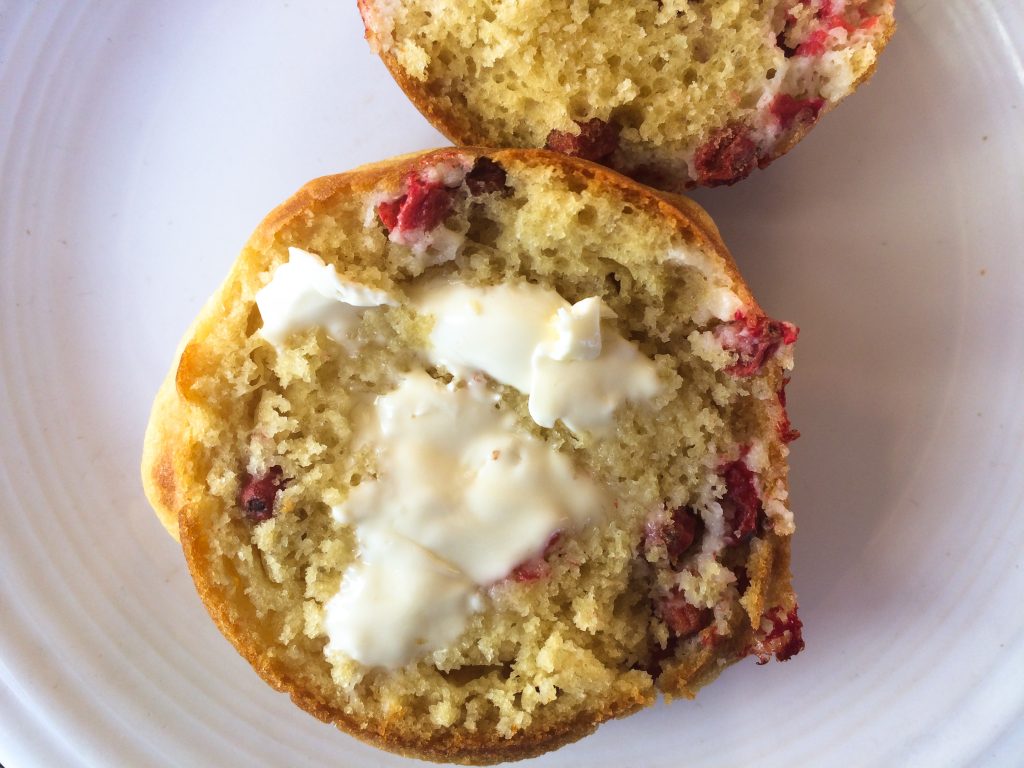
I almost always prefer to accentuate the positive, but when I come across a technique that doesn’t work, I feel like it’s my duty to save you the time and aggravation of figuring it out for yourself. After reading several recipes that recommended using whole autumn olive fruit (aka silverberries aka Eleagnus umbellata) I decided to see for myself whether this was a good idea. I was pretty sure it wasn’t, but the authors of those recipes claimed that cooking softened the seeds enough to make them palatable. I’m here to tell you, it doesn’t! Don’t waste your autumn olive fruit or your time.
First I made muffins, which baked for a mere fifteen minutes. And while I didn’t crack a tooth on the seeds, they were not fun to eat. I forced the baked goods on a few unsuspecting friends and family members who agreed they’d rather not eat them again. So sad.
Next I tried a simple quick bread recipe. I thought the longer baking time might soften the seeds enough to make them palatable. Nope. Each bite was disconcertingly unpleasant to chew. Instead of looking forward to a burst of fruity goodness, I dreaded biting down on the seeds, and ended up throwing away most of the loaf.
I was really hoping I was wrong about this, because it would certainly streamline the baking process to be able to leave the fruit whole. Alas, that was not to be. I’ll continue to use the pulp and juice in quick breads, pies, boozy infusions, and jellies, where their pretty color and excellent flavor can be appreciated without worrying about an emergency visit to the dentist.
Totally agree! The pulp and juice of the fully ripe Eleagnus umbellata drupes are the only parts worth processing. The seed and its tough, fibrous shell may not be poisonous but they certainly are not pleasant. A friend and I wasted the better part of a day creating autumn olive fruit leather with them in the matrix. Disgusting!
So glad I didn’t try that, Mike!
I tried this with jam this year. I regularly will just eat the whole fruit and I love the jelly it makes, but the jam was unpleasant. The flavor is still amazing, but trying to chew through seeds was annoying in my jam. It seemed to make the seeds more tough to chew through, similar to the outer shell of a sunflower seed. It certainly was a learning experience.
I’m so sorry Katie, what a disappointment. My friend Mark had a similar experience with a hackberry – wild grape jam. The flavor was great, and he thought the seeds would soften during the cooking process, but they never did.
We have an invasive called russian olive. Is that similar to this berry? They are silvery in color but no shell.
Russian olive is Eleagnus angustifolia and autumn olive is Eleagnus umbellata, so they aren’t the same plant, but they are cousins in the same genus. Russian olive is very common where I live now (in NM) but the fruit isn’t as tasty or versatile as autumn olive, although I’m still working on ways to use it. I find the flavor to usually be too astringent, but every once in s awhile I come across a tree that has tasty fruit, which makes a good jelly. The texture of Russian olive is dry and mealy, even when ripe, unlike autumn olives, which are quite juicy.
Funny, I like the seeds and had no trouble eating them. They did soften up in my jam too! All my friends so far felt the same as me. While I did use a food mill and removed a lot of the seeds I used a bigger hole blade so a lot of seeds would still work through. To each their own I guess.
Yes indeed, to each their own. I’m glad you can enjoy the seeds. My family and I were all afraid we’d break a tooth and it def wasn’t worth the dental bills!
Has anyone try to make jelly instead of jam??
Yes! The juice makes an excellent jelly and also a great pie filling (use your favorite lemon meringue pie recipe and substitute for the lemon juice). I’ve done both!